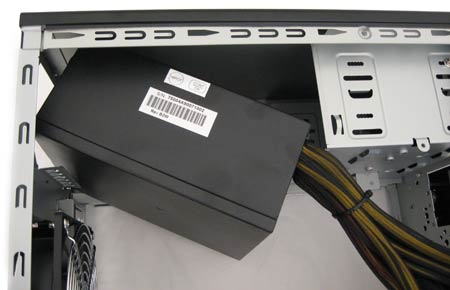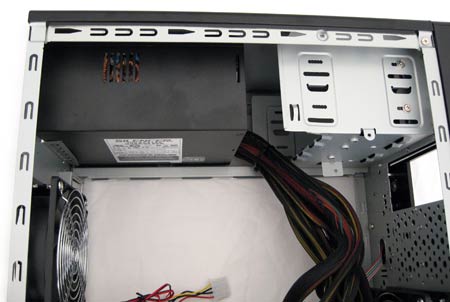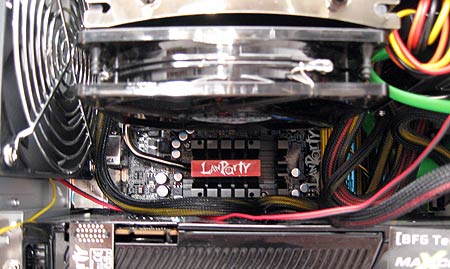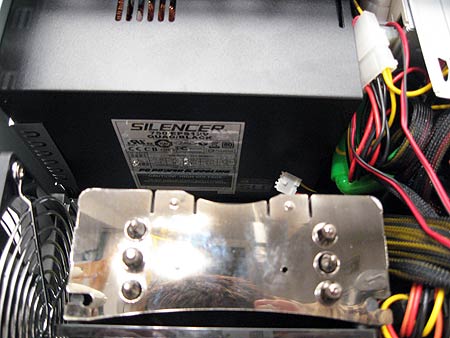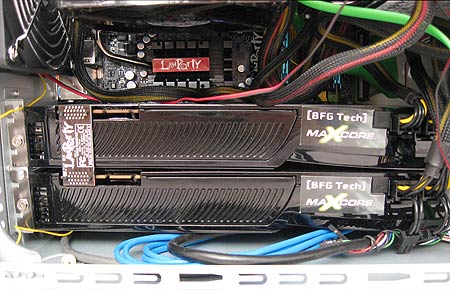System Builder Marathon, May '09: $1,300 Enthusiast PC
Assembly
Let me start off by saying that I don’t put a lot of Micro-ATX machines together, and now I remember why; it’s a lot less fun and takes a lot more planning, a lot more time, and can be a lot more frustrating if things don’t go as planned. In general, there has to be a lot more attention paid to cable management, because there just simply isn't much space in which to squeeze everything. Having said that, the results can be more rewarding as well.
Let’s begin with our first challenge: simply inserting the PC power-and-cooling PSU into the case. Initially, the power cables were too tight against the optical drive bay to allow the power supply to be mounted inside the small case.
A little bit of simple case modification was able to solve this issue. Specifically, we used some tin snips to cut part of the optical drive cage so we could fold it out of the way of the PSU cables.
With this issue out of the way, everything else fell into place without any more "hardware editing." But this doesn’t mean that we didn’t suffer from any more unexpected issues. Our next challenge was installing the Xigmatek Dark Knight CPU cooler.
There was no specific problem with the cooler itself. The included retention bracket worked like a charm and would securely mount the large cooler to the motherboard. The problem was that the cooler’s heatpipes would interfere with the DFI LANParty Jr. motherboard’s heat sinks, making it impossible to mount the CPU cooler in such a way that would force CPU-heated air towards the rear case fan, and therefore, out of the case.
We were left with no choice except to channel heated air upwards (toward the PSU) or downwards (toward the video cards). Given these choices, we would prefer to force it upwards toward the PSU so that it could be channeled through the power supply and out of the rear of the case.
Unfortunately, in this specific application, the PC Power and Cooling S75QB PSU does not pull air from below like a lot of ATX PSUs do–one fan pulls air in from the front of the PSU, and then another fan forces it out the rear. The bottom of the PSU is solid, and pushing CPU heated air upwards into a brick wall isn’t our idea of a good time.
Get Tom's Hardware's best news and in-depth reviews, straight to your inbox.
We were left with no choice at all, really: we had to push the CPU-heated air downward, towards the graphics cards. This is, admittedly, far from ideal.
This amounts to a perfect storm of bad luck. If we were able to position the CPU cooler to push heated air out of the back of the case, this wouldn’t have been an issue, and if the PSU had an intake fan on the bottom, it wouldn't have been a problem either. I’ll take some of the responsibility for this as well, as I could have been more diligent in anticipating these issues. I’ve been spoiled working with full ATX cases with plenty of room for moving air around. So, let this be a lesson to you folks who are planning on building a portable Micro-ATX system. Pay attention to the cooling details and anticipate how your cooler, motherboard, case, and PSU will work together, as sometimes choosing what appear to be ideal components for the price isn’t enough.
In any case, the system came together well despite the less-than-ideal cooling situation. We were a little concerned about how little space the graphics cards had to pull in air. The GeForce GTX 260 mounted at the bottom of the case is particularly concerning as its intake fan pressed closely to the floor of the case, restricting the amount of air it could draw. It was as tight as a can of sardines, but it booted and ran without problems. At least at first…
We experienced some instability when running game benchmarks at 1920x1200 with 4x anti-aliasing (AA) applied. Despite GPU temperatures being reported in what seemed a reasonable 75 degree Celsius range under load, we wondered if the graphics cards were overheating.
To test our theory, we used Nvidia’s System Tools utility to manually increase the graphics cards fan speed to 100%. Our fears were confirmed when the benchmarks ran without a hitch, indicating that the cards were overheating at stock fan speeds. Would this have happened if we were able to push the CPU-heated air out of the back of the case? It’s hard to say.
Without any real way out, we let the graphics card fans spin at 100% duty cycle to continue the benchmarks and keep the system running smoothly. We’ll address the increased noise and a method for minimizing the impact of this problem a little later in the benchmark section.
Current page: Assembly
Prev Page Power Supply, Optical Drive, And Video Cards Next Page OverclockingDon Woligroski was a former senior hardware editor for Tom's Hardware. He has covered a wide range of PC hardware topics, including CPUs, GPUs, system building, and emerging technologies.
-
jtnstnt It looks like you guys have a fetish for silverstone sff cases, and small motherboards. You guys probably like other small things...Reply -
one-shot Was the peak power draw measured from the wall? If so, do you know the efficiency of the PSU to determine the approximate power draw from the components at a given level of output? Overall, great article. I hope my 650Watt PSU with 3 X 19A 12V rails can handle another GTX 260 Core 216.Reply -
serifus if you wanted to go SFF it would be nice to see one done in an LIAN-LI PC-A05NB. at least you still get the full atx boards in those.Reply -
SpadeM ReplyThis system is no slouch and cuts through our new gaming benchmarks like a hot knife through butter.
I wonder how exactly does the selection of components go. I mean it seems that there's some attention given to the forums to be politically correct, but that's kind of it. For $1300 a Phenom 2 + micro AM3 board + 2x4890 in crossfire is a much better solution so .. why not choose the better option?
-
capttylor34 That system looks quite crowded on the inside, and that Dark Knight is big for a regular sized system, I'm actually kind of impressed you managed to fit it in a Micro ATX at all. I suppose as long as it runs stable, theres really no problem. Still think the articles should be titled "Micro System Build-off" just to let people know off the bat what they're about to read.Reply -
IzzyCraft SpadeMI wonder how exactly does the selection of components go. I mean it seems that there's some attention given to the forums to be politically correct, but that's kind of it. For $1300 a Phenom 2 + micro AM3 board + 2x4890 in crossfire is a much better solution so .. why not choose the better option?Reply -
armistitiu I'm tired of seeing I7 920 in every damn "recommended" PC. I'm not saying go AMD but please just try to vary them a bit it's getting stupid. Also try building your own benchmarks or at least change them once in a while.Reply
Btw i\m getting tired of people picking up I7 and saying "because i do heavy CPU tasks" (not necessarily IzzyCraft ) and in fact all they need is a browser,OpenOffice and WoW minimized in the taskbar.
The article is well done no doubts but try using other brands also. It\s starting to sound biased.
-
ohim This article would be great if you could do : what you can buy for 1300 Intel parts and what you can by for 1300 AMD parts ... and put the 2 PCs to compeat to eachother :P it would be a more interesting article than just buy a pc and ... show what ?Reply -
nerrawg Nice slick system this - looks like 2 x 260's is pretty good value at 1920 x 1200 for those that want to max out the settings in the most demanding games. Was wondering however if there is a good technical explanation for the power consumption results because they seem pretty strange?Reply

